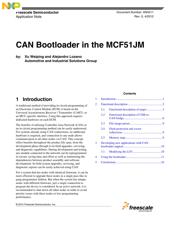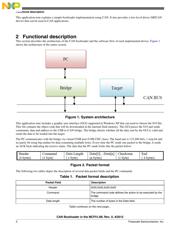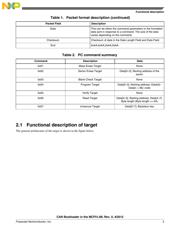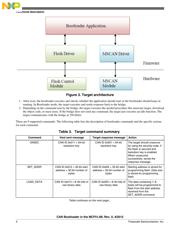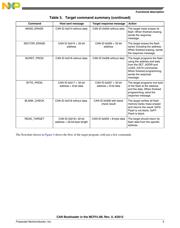Datasheet 搜索 > 微控制器 > NXP(恩智浦) > MCF51JM128VQH 数据手册 > MCF51JM128VQH 用户编程技术手册 1/17 页

 器件3D模型
器件3D模型¥ 90.527
MCF51JM128VQH 用户编程技术手册 - NXP(恩智浦)
制造商:
NXP(恩智浦)
分类:
微控制器
封装:
QFP-64
描述:
NXP MCF51JM128VQH 芯片, 微控制器, COLDFIRE V1, 50.33MHZ, QFP-64
Pictures:
3D模型
符号图
焊盘图
引脚图
产品图
页面导航:
功能描述在P2P3P4P5P6P7P8P9
导航目录
MCF51JM128VQH数据手册
Page:
of 17 Go
若手册格式错乱,请下载阅览PDF原文件

1 Introduction
A traditional method of providing in-circuit programming of
an Electronic Control Module (ECM) is based on the
Universal Asynchronous Receiver / Transmitter (UART), or
an MCU-specific interface. Using this approach requires
dedicated hardware on each ECM.
The benefits of utilizing Controller Area Network (CAN) as
an in-circuit programming method can be easily understood.
For systems already using CAN connections, no additional
hardware is required, and connection to any node allows
communication to all other nodes via CAN. This concept
offers benefits throughout the product life span, from the
development phase through to in-field upgrades, servicing,
and diagnostic capabilities. During development and testing,
any module connected to the network can be reprogrammed
in-circuit, saving time and effort as well as minimizing the
dependencies between product assembly and software
development. In-field system upgrades, servicing, and
diagnostic reports can be easily achieved using CAN.
For a system that has nodes with identical firmware, it can be
more efficient to upgrade these nodes in a single pass like in
gang-programmer fashion. But when the system has unique
nodes with different firmware, just a single connection to
program the device is considered. In an active network, it is
recommended to shut down all other nodes in order to avoid
priority issues with these nodes or low-programming
performance.
Freescale Semiconductor
Document Number: AN4511
Application Note
Rev. 0, 4/2012
CAN Bootloader in the MCF51JM
by:
Xu Weiping and Alejandro Lozano
Automotive and Industrial Solutions Group
© 2012 Freescale Semiconductor, Inc.
Contents
1 Introduction................................................................1
2 Functional description...............................................2
2.1 Functional description of target......................3
2.2 Functional description of USB-to-
CAN bridge....................................................6
2.3 File image parser............................................9
2.4 Flash protection and vector
redirection......................................................9
2.5 Memory map..................................................9
3 Developing new applications with CAN
bootloader support..................................................10
3.1 Modifying the LCF......................................10
4 Using the bootloader...............................................11
5 Conclusions.............................................................16
器件 Datasheet 文档搜索
AiEMA 数据库涵盖高达 72,405,303 个元件的数据手册,每天更新 5,000 多个 PDF 文件
